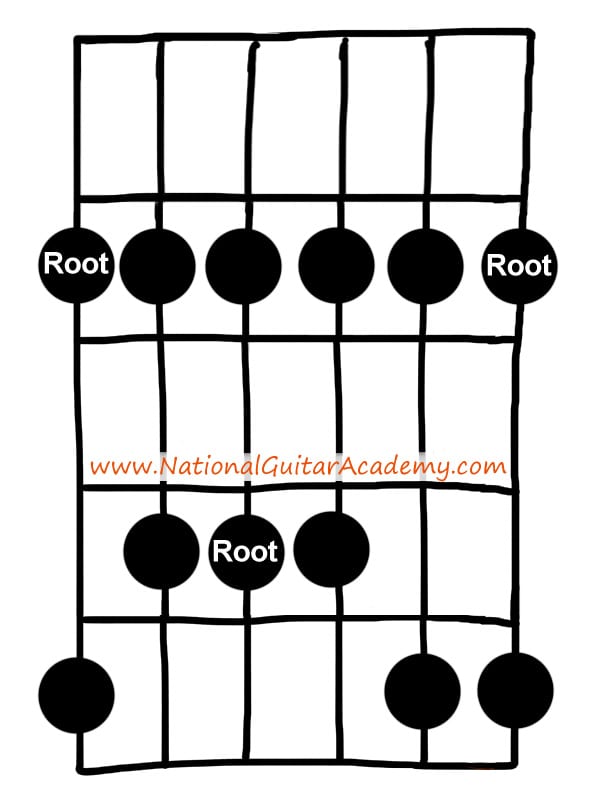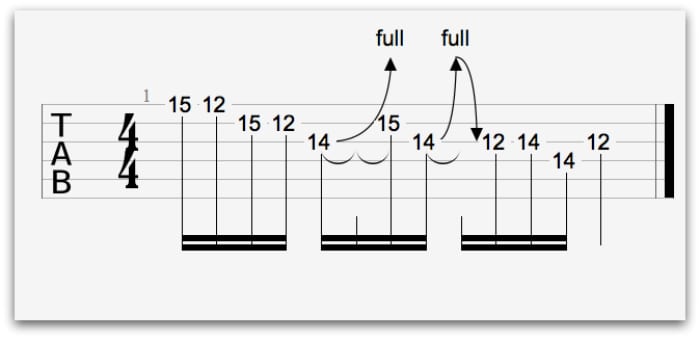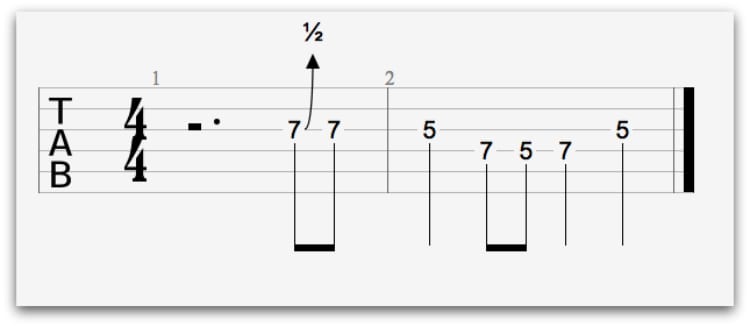Want to learn about the pentatonic scale? Strap yourself in for this super-useful lesson.
In this free guitar lesson you will learn:
- Why this scale is the ONE scale every guitarist must know
- 8 essential pentatonic licks
- 5 easy pentatonic tricks that make you sound amazing
- The #1 secret to learning pentatonic scales fast
Over 250,000 guitar-learners get our world-class guitar tips & tutorials sent straight to their inbox: Click here to join them
What is the pentatonic scale?
A pentatonic scale consists of 5 musical notes. (In Latin “penta” means five and “tonic” means tone. So pentatonic is just a fancy way of saying “five notes”.)
Technically, a pentatonic scale could be any 5 tone scale, but in practice when guitarists refer to the ‘pentatonic scale’, 99% of the time they are referring to the minor and major pentatonic scale.
Here is the classic pentatonic scale shape:
This is in A minor, but the scale pattern is MOVEABLE. You could play the same pattern two frets higher and you would be playing B minor.
(One higher would be C. Two higher would be D, and so on.)
A Minor Pentatonic Scale
So what is a “minor pentatonic scale”?
- The minor pentatonic scale is a minor scale that contains 5 notes.
- Minor scales tend to have a dark, bluesy sound.
- They are perfect for rock and blues music.
The minor pentatonic scale is one of the first scales you should learn as a guitar player, it’s simple and easy to learn.
What is a major pentatonic scale?
- The major pentatonic scale is the major scale, but with 2 notes removed. (So instead of having 7 notes, it has 5.)
- Important point: The major pentatonic scale is simply the major scale, in abridged form.
- This scale has a brighter sound than the minor pentatonic and is fantastic for pop, blues and jazz.
Both of these scales are essential to know for every musician.
A vital point…
CRUCIAL POINT: The minor and major pentatonic scales use the same scale patterns. When you learn the minor pentatonic scale patterns you are also learning the major pentatonic scale patterns.
This is because of ‘relative’ keys. For example, the C Major Scale shares the same notes as the A Minor Scale.
The notes contained in both scales are: A, B, C, D, E, F, G
- The root note in C Major is C – The notes are A, B, C, D, E, F, G.
- The root note in A Minor is A – The notes are A, B, C, D, E, F, G.
Can you see that the notes are the same?
So the scales are the same. The only difference between them is the root note. This means that the note you finish your licks and phrases on would change, depending on the key. The patterns of the scale are the same.
This is a huge timesaver! When you learn the Minor Pentatonic Scale patterns, you are also learning the Major Pentatonic Scales patterns at the same time. This is so cool!
Theory vs Practical
Now we’re going to look at some tricks and licks you can play.
If you’re interested in the theory that underpins the minor and major pentatonic scales, you’ll find that further down the page, after these practical tips.
5 cool licks and licks in the E minor pentatonic scale
In this video Mike shows you 5 cool flicks and licks from the E minor pentatonic scale:
Download our lead guitar cheat-sheet to make things easier
It's hard to understand which scales work with which keys.
So we created a cheat-sheet! A key and scale-finder that you can use again and again.

Get your personalised guitar-learning plan 🎸
Get a custom guitar-learning plan here: Click here for GuitarMetrics™
World-Class Guitar Courses 🌎
Learn from the world's best guitar educators: Click here for our guitar courses
Pentatonic Scale Guitar Licks: 3 Essential Licks
Here’s some more cool licks. Let’s dive in!
What’s a lick?
A lick is kind of like a small phrase in a language, it’s purely a musical statement. Naturally, licks are smaller than scales, there designed to create music. It’s just a short phrase.
Fancy learning a few?
Lick 1: The ‘Country’ Lick
The major pentatonic scale is used a lot in country music, here’s a classic country style major pentatonic lick in G major:
Watch out for the bending on this lick, if you’re a little bit stuck on how to bend guitar strings. Check out this article on lead guitar playing: How To Play Lead Guitar
Lick 2: The ‘Blues’ Lick
The minor pentatonic scale is often used in blues music, it’s a great way of getting a great blues sound.
This lick has a bit of a clapton vibe to it, it’s great for those old school blues tunes.
.
If you want to know more about the A minor pentatonic, go here :Learn Guitar Scales In 8 Easy Steps
Want free guitar tips and video lessons delivered to your inbox?
Join over 250,000 guitar learners and subscribe to our guitar-tips-by-email service. (It's free.)
We'll send you a series of lessons that will move you to the next level of your guitar journey.
Learn how everything fits together quickly, easily and effectively. We share ninja tips (for instant fun!) but also timeless fundamentals that will deepen your understanding.
Our Guitar Courses
To become a better guitarist click here to see our guitar courses
Get your personalised guitar-learning plan 🎸
Want us to make a guitar-learning plan that is customised to you? Click here for GuitarMetrics™
Lick 3: The ‘Rock’ Lick
This next lick is an awesome minor pentatonic rock lick. Buckle up! It’s a fast one.
Here’s the tab :
This lick is in the key of A.
Learning the minor pentatonic scale
As the minor pentatonic scale has 5 notes, it’s useful for us to know what those notes are.
You don’t need to know this to play a pentatonic scale on the guitar, but it’s SO useful to understand this if you want to take your musical playing to the next step.
We can either think of these notes via intervals or via note names.
Learning the intervals of the minor pentatonic scale
When talking about musical intervals, we’re referring to :
The relationship that two notes have together.
In scales, 99% of the time we’re always referring to the root notes relationship with another note in the scale.
So for example, let’s say we’re learning :
- The E minor pentatonic scale.
From this, before we learn any of the notes in the E minor pentatonic scale, we know that :
- The root note of that scale is the note E. This is our starting note.
So therefore, we can relate ANY of the other notes in the scale, back to the root note.
This is what we’re referring to when we talk about intervals.
Intervals in the minor pentatonic scale
These are :
- The Root
- The Flattened 3rd
- The Perfect Fourth
- The Perfect Fifth
- The Flattened 7
These intervals are ALWAYS going to be the same in the minor pentatonic scale, regardless of what key we’re playing in.
This is the blueprint of the minor pentatonic scale.
It’s also useful to know the names of each note in a scale, however this changes depending on what key you’re in. Notes change, but the blueprint stays the same.
Let’s learn this scale in the key of E minor.
Notes in the E minor pentatonic scale
These are :
- E – The Root
- G – The Flattened Third
- A – The Perfect Fourth
- B – The Perfect Fifth
- D – The Flattened Seventh
This diagram, shows you ALL of these notes on the fretboard:
E Minor Pentatonic – Full Fretboard
If you’d like to know more about guitar scales, go here : Learn Guitar Scales In 8 Easy Steps
Over 250,000 guitar-learners get our world-class guitar tips & tutorials sent straight to their inbox: Click here to join them
Get our best guitar tips & videos
Where should we send it?
Get our best guitar tips & videos
Get our best guitar tips & videos













